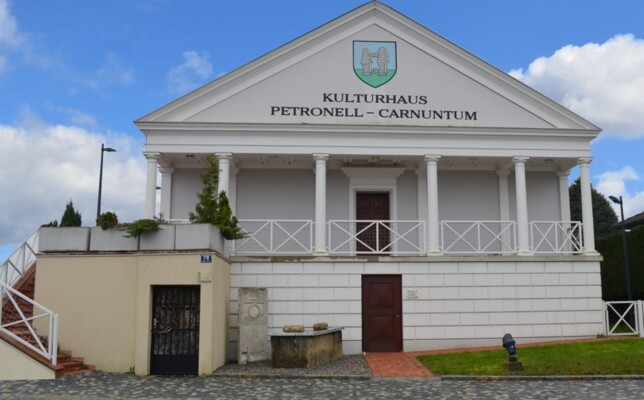Petronell-Carnuntum (Austria)
Museum Auxiliarkastell Petronell-Carnuntum
The excavations at the Auxiliary Fort brought numerous finds and exciting excavation findings to light. The abundance of finds from this equestrian camp necessitated accommodation and a visitor-friendly presentation. Since 1989, the museum, which is run by the Auxiliary Fort Museum Association, has been housed in the cultural centre purchased by the municipality in 1987. The first exhibition in 1989 dealt with the topic of "Graves and the Cult of the Dead in the Carnuntum Area" and was set up in the basement of the house. After years of renovation work and the help of many volunteers, the house of culture was finally officially opened in 2008. The museum has three exhibition rooms: Exhibition room 1 deals with "Ancient Water Technology in Carnuntum" by showing remains of drinking water pipes, wells, springs and sewers. These guaranteed the vital drinking water supply and waste water drainage for the military and civilian population. Thanks to loans from the Carnuntum Archaeological Park in the form of water pipes made of clay and lead, the exhibition was expanded in 2016. Exhibition room 2 is dedicated to the equestrian camp of the provincial capital of Carnuntum and the documentation of the excavations under HR Dr. Manfred Kandler (Austrian Archaeological Institute). Selected exhibits and text panels give an insight into the strictly organised life of Roman auxiliary soldiers under the motto "PVGNA ET LABORA" (fight and work). In the deep cellar of the museum is the "highlight" of our display objects, well protected by an underground shelter built by the Kallinger company. It is a crossing structure of a sewer and a drinking water pipe, unique in the entire empire, which deviates from the classical Roman building regulations. In the rear garden area of the Kulturhaus is the lapidarium with twelve gravestones, which come from the burial ground around the Auxiliary Fort. They are like the life stories of former inhabitants carved in stone and therefore provide intimate insights into their private lives.
Access preferences
- Museum For Future (Environmentally responsible)
Museum Auxiliarkastell is a Museum For Future
Our Museum Auxiliarkastell Petronell-Carnuntum is part of the Museums For Future platform. This means that we are part of the worldwide movement of museums, cultural institutions and their employees, alongside other museums such as the Museum Niederösterreich, the Technisches Museum Wien or the Museum Arbeitswelt Steyr.
We stand behind the demands of Fridays For Future and thus the best available climate science: the fastest possible and most effective climate policy measures are necessary and without alternative in order to achieve the Paris climate goal and thus an ecologically stable, liveable future for all. We take our responsibility as institutions of science, education and discourse seriously, and work for a sustainable society in the service of the public.
Climate and the environment were already important issues for the Romans. Water was an indispensable resource and was considered a common good - the management of which was one of the highest Roman offices. Maintaining water quality was important. Therefore, aeration and inspection shafts were installed in the water pipes at regular intervals. The famous architect Vitruvius already recommended filtering the water that was stored in the cisterns. He already knew chemical methods to examine the water quality.
But sewage disposal also played an important role. Only in a clean city could the spread of epidemics be prevented.
Just as in Roman times, we must take care today not to destroy our livelihoods. That is why we welcome the Museums For Future action platform and are happy to be a part of it.
Let's hope that more and more different social voices get involved and that cultural institutions become more audible.
More information at www.museumsforfuture.org
Contact info
Museum Auxiliarkastell Petronell-Carnuntum,
Hauptstraße 78,
Petronell-Carnuntum, Austria.
+43 664 736 74 493
museum@auxiliarkastell.at
https://www-auxiliarkastell-at.translate.goog/?_x_tr_sch=http&_x_tr_sl=de&_x_tr_tl=en&_x_tr_hl=es&_x_tr_pto=nui,elem